Water Conservation
Regional Water Conservation Strategy
For further information, please visit RDOS Regional Connections.
The RDOS recognizes that water is a valuable resource that should be used wisely. By working together to use water as efficiently as possible in regional district operations, private dwellings, agricultural operations, and commercial enterprises, the RDOS can lead the way in ensuring that its water systems are resilient and sustainable into the future.
2017 Regional Water Conservation Strategy - Econics
The Regional District adopted a District-wide Regional Water Use Regulation Bylaw and Regional Water Conservation Strategy specific to the Okanagan-Similkameen. The cross-connection control bylaw was presented to the board in early 2021. The implementation of this bylaw will complete the unification of water use standards across all electoral areas within the RDOS-owned and operated water systems. These bylaws guide the regulation and use strategy for our precious resource of clean water. The focus of which is on water conservation/efficiency and sustainable water management, integration of extreme weather management recommendations (e.g. drought and flooding), inclusion of climate change and consistent interpretation of the appropriate regulations.
Throughout the summer, the Province of BC issues water restrictions that may not match with local water restrictions. The province manages water on a broader scale and their restrictions apply to agricultural irrigators and commercial users that have been issued water licenses for either surface or groundwater sources. When the RDOS adjusts water restriction stages, it applies to all users whether agricultural or residential, associated with the small water systems we manage. While we work closely with many agencies regionally to assess conditions that affect source water for our systems, the restriction levels often vary. As a resident in the RDOS, follow the restrictions set for your source water supply.
Okanagan-Similkameen Rain Garden Guide Book
Water is always an important consideration in the semi-arid climate of the southern interior region across all user groups; recreational, during the subdivision development process, in the commercial/industrial environment, utility infrastructure (purveyance), agricultural or in and around the household.
The Regional District of Okanagan-Similkameen (RDOS) provides residents information on water conservation and conducts outreach workshops throughout the region, especially in those communities where the district owns or manages the water system.
The Okanagan-Similkameen Rain Garden Guide Book is an example of the commitment to providing residents information on conservation, rain capture, re-use options and best practise guides. These guides demonstrate how ‘partnerships’ can broaden and improve the overall reach or effectiveness of a project, workshop series or publication. Joining with our local government partners the Okanagan Basin, other water conservation agencies and the Royal Bank of Canada’s Blue Water Project, these guide books were created to introduce the benefits of rain gardens as ways to slow, spread and sink rain water run off back into the earth.
These information booklets are free to download and share either in part or in whole.
 Okanagan-Similkameen Rain Garden Guide Book
Okanagan-Similkameen Rain Garden Guide Book
RDOS Drought and Flood
Water Conservation Plans
The purpose of a Water Conservation Plan is to provide the community a strategy for conserving water and the associated electricity and greenhouse gas emissions related to the delivery of potable water. Along with cost savings, it will ensure continued eligibility when applying for infrastructure grants and support government policies and strategies.
Water Conservation Plans detail the quantifiable and non-quantifiable benefits to determine the best course of action for a sustainable, resilient water system.
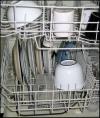
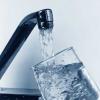
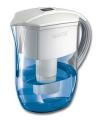
Inside Water Reduction Ideas:
Kitchen
Dishwasher: Make sure that the dishwasher is totally full when using it. Using the dishwasher to wash a full load of dishes requires less water than if you were washing them by hand. The dishwasher uses an average of 1.4% of the water consumed within a household per day.
Kitchen Faucets: By installing a low flow faucet aerator you can reduce the amount of water that flows out of your taps. Regular checks for leaks above and below sinks are also key in reducing water waste. Household faucets use about 15% of the water used in a household per day. One faucet dripping at one drip per second can waste up to 757 litres of water a year about 195 4L milk jugs!
Cold Water: Place a jug of water in the fridge. This will reduce the amount of time spent running the tap for cold water. When water has had a chance to sit the chlorine has a chance to dissipate, this will remove the chlorine flavour from the water too.
Washing: When washing dishes by hand don’t run the tap for rinsing
Fruits and Veggies: Instead of running the tap, wash your fruits and vegetables in a pan which you can then use to water indoor or outdoor plants.


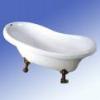

Bathroom
Shower: By installing low water usage shower heads the amount of water used can be drastically decreased. The average household uses 17% of its water during showers. Decreasing shower times from 8 minutes to 5 minutes can save up to 28 litres of water (imagine, 7, 4L milk jugs sitting in your shower).
Toilet: Older toilets may use up to 26 L of water per flush, this is an outstanding number when compared to toilets that are high efficiency and use only 6L of water.
Is your toilet leaking? It may be and you might not even know it. By placing food colouring in the tank and waiting 15 min to see if colour appears in the bowl you can detect these silent leaks.
Placing a pop bottle filled with water in your toilet tank will also reduce the amount of water your toilet uses; just make sure that it’s not in the way of the toilets mechanisms.
Only use the toilet what it was intended for. Put tissues in the waste basket and food products in the compost.
Do not flush hygiene wipes or 'wet wipes' as they will clog septic systems and lines and back up municipal sewer systems.
Bathtubs: Bathtubs are set volumes but there are things that can be done to reduce the amount of water that is used. By making sure that your plug isn’t leaking and that your bathtub isn’t overfilled, you can reduce water usage. Also in a drought, reusing this “grey water” to water plants or lawn can be effective; however, caution should be utilized when reusing this water because many soaps contains harmful phosphates, and nitrates that can damage plants.
Taps: While brushing your teeth turn off the tap. Running the water when it’s not being used isn’t necessary.

Laundry
Washing Machine: The single most important improvement that can be made is to replace old washing machines with new high efficiency ones. Traditional washing machines use up 155 litres of water per load versus high efficiency machines that use only 87 Litres of water per load.
Washing full loads of laundry is the most efficient way to wash clothes, even if the machine has adjustable water levels.

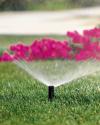

Outdoor Water Reduction Ideas
Irrigation:
Manual irrigation: in order to reduce water evaporation watering lawns and gardens between 10pm and 5am is advisable. If you water in the middle of a hot day 60% of water can be lost to evaporation, watering during cooler times of day significantly reduces this percentage. Avoiding sprinklers that oscillate, produce mists or fine sprays also aids in the reduction of water loss due to evaporation. Maintaining hose connections to avoid leaks also prevents water loss.
Monitor your sprinkler coverage; make sure that you’re not watering the pavement or sidewalk. Make sure that sprinkler and irrigation heads aren’t broken.
Don’t water on windy days, the water will just blow away and be more susceptible to evaporation.
Automatic Irrigation: Automatic irrigation systems often waste more water than a manual system. Checking and adjusting your automatic irrigation once a month is recommended. By checking your irrigation system once a month, you are better able to follow the odd/even water restrictions and also adjust for the upcoming month’s weather.
Drip Irrigation: uses 30%-50% less water than regular watering methods. Drip irrigation can be simple or elaborate. Drip irrigation lines are low to the ground or buried and drip directly on to soil and down into root sources. This provides sufficient water for the plant, while drastically reducing the amount of water that is lost to evaporation. Drip irrigation provides deep soil saturation and prevents soil and nutrient run off.
At home “Do it Yourself” solution: to mimic the effect of expensive drip lines:
Punch tiny holes into 2L plastic bottles or milk jugs, place in garden beds and fill with water. This is an inexpensive solution that provides plants with direct water contact. Make sure that the lid is placed on the tops of the containers, this will help reduce evaporation.
Soaker Hoses: By installing a soaker hose system around your garden, you can help minimize the work and efforts involved in watering and maximize water efficiency. This low level watering system (hoses or pipes laid along the ground) delivers the water very close to the plants’ roots and requires only a low pressure water supply.

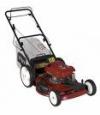

Lawns
Watering Lawns: train your lawns! Watering a lawn everyday encourages shallow root growth. By spreading out the watering of your lawn you’ll encourage deeper root growth, and by saturating the soil occasionally the grass will become healthier and drought resistant. Grass generally requires 1” or 2.5cm of water per week. To measure how much water your lawn needs place a can or jar with a mark of 1” or 2.5cm on it and place it in a location that receives good sprinkler coverage. When the water is at the 1” or 2.5cm mark turn off your irrigation.
Mowing Lawns: when mowing your grass you should only be removing 1/3 of the grass stalk or keeping the grass 2.5” long. By keeping grass longer it provides more root shade, discourages weed growth, and retains more water. Mower blades should be kept sharp, dull blades rip and tare grass and it becomes more susceptible to disease. “Grasscycling” also provides free fertilizer, helps grass grower greener and denser and doesn’t cause thatch build up. Healthy lawns with deep root systems are more draught resistant.
Grass- What grass do you choose? Using low water, low maintenance grass reduces the time and effort you spend caring for your grass. Grasses such as enviro-turf or drought resistance grasses root deeper and grow slower than regular varieties.

Xeriscape
Xeriscape is designing a landscape so that it fits within the natural environment’s climate and its water constraints. Xeriscape is a landscape that is healthy, and responsive to the Okanagan’s desert.
The 7 Principles of Xeriscaping:
1. Develop- a landscape design plan that accounts for rrgtion and maintenance.
2. Reduce -turf and high water use areas.
3. Improve- soil conditions by using soil amendments
4. Select- appropriate drought resistant plants
5. Mulch- soil to reduce the evaporation of water and to protect against erosion.
6. Irrigate- efficiently, whilst employing water smart practices.
7. Create- a maintenance program that is efficient in its use of resources, including time and money.
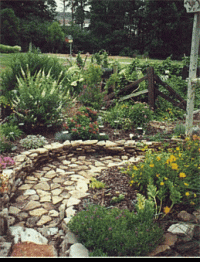
Xeriscape Plants:
What does a xeriscape plant look like and what makes it drought resistant? When choosing a plant for your xeriscape look for the following features:
-Silver leaves- reflect light, aiding in the prevention of heat absorption.
-Deep roots- tap deeper water reserves making them more capable of retaining water and the roots keep cooler when they are further down in soil.
-Fine textured shrubs-have a reduced surface area, providing less opportunity for evaporation.
-Waxy leaves- the coating prevents water evaporation from the surface of the leaves.
-Water retentive sections- pillow like appearance such as aloe vera hold their water internally and do not have leaves. This lack of leaves helps to prevent water loss.
Visit your local garden center for more information about Xeriscape plants.



Mulch:
What is mulch? What does mulch do?
Mulch is left on the soil surface. Its purpose is to reduce evaporation and runoff, inhibit weed growth, and create an attractive appearance. Mulches also moderate soil temperature, helping to warm soils in the spring and cool them in the summer. Mulches may be incorporated into the soil as amendments after they have decomposed to the point that they no longer serve their purpose.
There are two types of mulch, organic and inorganic. Organic such as grass clippings and wood chips may provide nutrients for plant use as they decompose. Inorganic mulch includes rocks and gravel. Mulch comes in many different shapes and sizes. Determining which mulch is right for a yard is a matter of preference, appearance and landscape.

Soil Amendment
A soil amendment is any material added to a soil to improve its physical properties, such as water retention, permeability, water infiltration, drainage, aeration and structure. The goal is to provide a better environment for roots.
To do its work, an amendment must be thoroughly mixed into the soil. If it is merely buried, its effectiveness is reduced, and it will interfere with water and air movement and root growth.

Naramata Water Conservation
The purpose of the Naramata Water Conservation Plan is to provide a strategy for conserving both water and the associated electricity and greenhouse gas emissions related to its production, delivery and use. This will save money for the users, ensure continued eligibility when applying for infrastructure grants, and assist in the implementation of government policies and strategies. The conservation plan will assist the community to achieve a 25% reduction in water use (based on 2010 usage) by the year 2020.
The Naramata Water Conservation Plan details the quantifiable and non-quantifiable benefits to determine the best course of action for the RDOS to take in the community.
The information presented in the Naramata Water Conservation Plan has been specifically calculated and aligned with current practices in this water utility to determine the conservation possible for the Naramata system.



